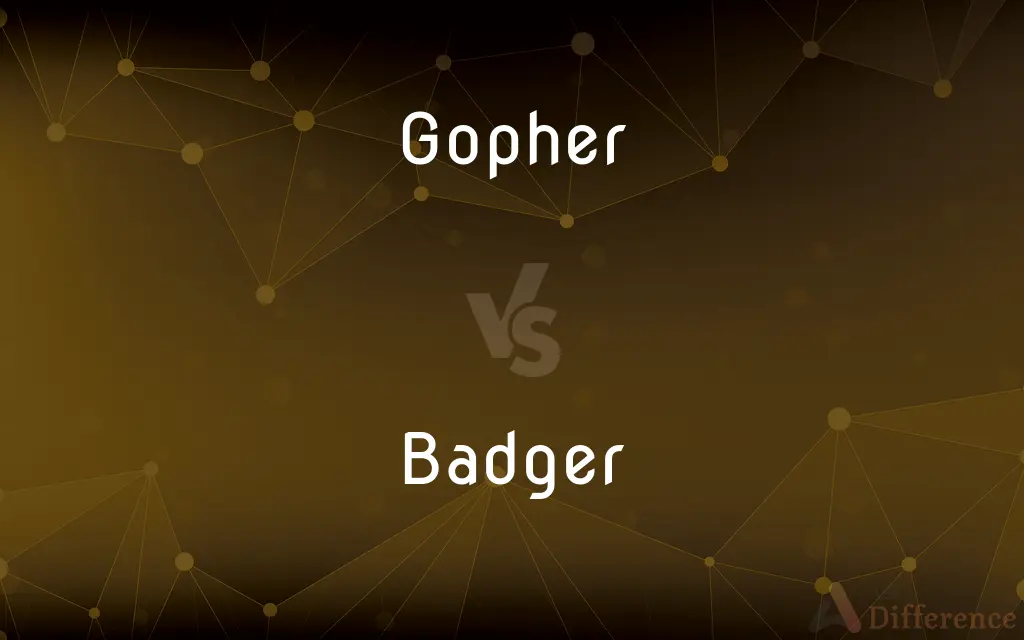Gopher vs. Badger — What's the Difference?
By Tayyaba Rehman & Maham Liaqat — Updated on March 26, 2024
Gophers are small, burrowing rodents known for creating extensive underground tunnels, while badgers are larger, omnivorous mammals with a broader diet and habitat range, recognized for their digging abilities.

Difference Between Gopher and Badger
Table of Contents
ADVERTISEMENT
Key Differences
Gophers are specialized rodents, primarily feeding on roots and tubers they encounter while digging their intricate tunnel systems. These animals are notorious among gardeners and farmers for damaging crops and landscapes. Badgers, on the other hand, have a more varied diet that includes worms, insects, small mammals, and plants, showcasing their adaptability to different environments and food sources.
While gophers spend a considerable amount of their life underground, rarely seen by humans, badgers are more versatile in their habitat use. Badgers can live in woods, plains, and even suburban areas, often seen at dusk or dawn. This difference in lifestyle impacts how each animal interacts with its environment and the visibility of their presence to humans.
In terms of physical appearance, gophers are smaller, with a typical length of 5 to 14 inches and equipped with large cheek pouches for carrying food. Badgers are significantly larger, measuring up to 35 inches long, and are characterized by their distinctive black-and-white striped faces, which make them easily recognizable.
Gophers are solitary creatures, maintaining individual tunnel systems that serve as their homes, food storage, and protection from predators. Conversely, badgers are known for their social structures in some species, such as the European badger, which lives in complex social groups called setts.
The impact of gophers and badgers on human activities also differs. Gophers are often viewed as pests due to their tunneling damaging crops, lawns, and even underground cables. Badgers, while they can cause issues through their digging, are more often admired for their role in controlling rodent populations and are protected in many areas due to their ecological importance.
ADVERTISEMENT
Comparison Chart
Size
Small (5 to 14 inches long)
Larger (up to 35 inches long)
Diet
Primarily roots and tubers
Omnivorous (worms, insects, small mammals, plants)
Habitat
Underground tunnels in a variety of landscapes
Woods, plains, suburban areas
Social Structure
Solitary
Solitary or social (species-dependent)
Interaction with Humans
Considered pests due to tunneling activities
Can be problematic due to digging but also valued for ecological benefits
Physical Characteristics
Large cheek pouches, sharp claws for digging
Distinctive striped face, powerful limbs for digging
Compare with Definitions
Gopher
A burrowing rodent of the family Geomyidae, known for creating extensive underground tunnels.
The farmer was troubled by gophers damaging his crop roots.
Badger
A member of the Mustelidae family, known for their digging ability and omnivorous diet.
The badger used its powerful claws to dig for earthworms.
Gopher
Characterized by fur-lined cheek pouches used for carrying food.
The gopher filled its cheek pouches with seeds before returning underground.
Badger
Some species live in social groups and have complex burrow systems called setts.
The setts near the forest edge were home to a family of badgers.
Gopher
Solitary animals, with each individual maintaining its tunnel system.
Gophers, being solitary, rarely interact with each other outside of mating season.
Badger
Can adapt to various habitats, from woods to suburban areas.
A badger was spotted near the suburban park, foraging at dusk.
Gopher
Have a significant impact on agriculture and landscaping.
Landscapers installed barriers to protect the garden from gopher damage.
Badger
Badgers have distinctive black-and-white striped faces.
The badger's striking striped face made it easily identifiable in the twilight.
Gopher
Identified by their small size and powerful digging claws.
The small, burrowing creature we saw in the garden was a gopher.
Badger
They play a role in ecosystem balance by controlling rodent populations.
Farmers appreciated the badgers for naturally managing the rodent problem.
Gopher
Any of various short-tailed, burrowing rodents of the family Geomyidae of North America, having fur-lined external cheek pouches. Also called pocket gopher.
Badger
Badgers are short-legged omnivores mostly in the family Mustelidae (which also includes the otters, polecats, weasels, and ferrets), but also with two species called "badgers" in the related family Mephitidae (which also includes the skunks). Badgers are a polyphyletic grouping, and are not a natural taxonomic grouping: badgers are united by their squat bodies, adapted for fossorial activity.
Gopher
Pocket gophers, commonly referred to simply as gophers, are burrowing rodents of the family Geomyidae. The roughly 35 species are all endemic to North and Central America.
Badger
Any of several carnivorous burrowing mammals of the family Mustelidae, such as Meles meles of Eurasia or Taxidea taxus of North America, having short legs, long claws on the front feet, and a heavy grizzled coat.
Gopher
Any of various ground squirrels of North American prairies.
Badger
The fur or hair of any of these mammals.
Gopher
See gopher tortoise.
Badger
Any of several similar mammals, such as the ratel.
Gopher
A small burrowing rodent native to North and Central America, especially in the family Geomyidae (true gophers).
Pocket gopher
Badger
To ask or nag (someone) about something in an annoying and persistent way; pester
Badgered the boy into cleaning his room.
Gopher
The ground squirrel.
Badger
Any mammal of three subfamilies, which belong to the family Mustelidae: Melinae (Eurasian badgers), Mellivorinae (ratel or honey badger), and Taxideinae (American badger).
Gopher
The gopher tortoise.
Badger
A native or resident of the American state, Wisconsin.
Gopher
The gopher rockfish.
Badger
(obsolete) A brush made of badger hair.
Gopher
One of several North American burrowing rodents of the genera Geomys and Thomomys, of the family Geomyidæ; - called also pocket gopher and pouched rat. See Pocket gopher, and Tucan.
Badger
A crew of desperate villains who robbed near rivers, into which they threw the bodies of those they murdered.
Gopher
One of several western American species of the genus Spermophilus, of the family Sciuridæ; as, the gray gopher (Spermophilus Franklini) and the striped gopher (S. tridecemlineatus); - called also striped prairie squirrel, leopard marmot, and leopard spermophile. See Spermophile.
Badger
(obsolete) An itinerant licensed dealer in commodities used for food; a hawker; a huckster; -- formerly applied especially to one who bought grain in one place and sold it in another.
Gopher
A large land tortoise (Testudo Carilina) of the Southern United States, which makes extensive burrows.
Badger
To pester; to annoy persistently; to press.
He kept badgering her about her bad habits.
Gopher
A large burrowing snake (Spilotes Couperi) of the Southern United States.
Badger
An itinerant licensed dealer in commodities used for food; a hawker; a huckster; - formerly applied especially to one who bought grain in one place and sold it in another.
Gopher
A zealously energetic person (especially a salesman)
Badger
A carnivorous quadruped of the genus Meles or of an allied genus. It is a burrowing animal, with short, thick legs, and long claws on the fore feet. One species (Meles meles or Meles vulgaris), called also brock, inhabits the north of Europe and Asia; another species (Taxidea taxus or Taxidea Americana or Taxidea Labradorica) inhabits the northern parts of North America. See Teledu.
Gopher
Any of various terrestrial burrowing rodents of Old and New Worlds; often destroy crops
Badger
A brush made of badgers' hair, used by artists.
Gopher
Burrowing rodent of the family Geomyidae having large external cheek pouches; of Central America and southwestern North America
Badger
To tease or annoy, as a badger when baited; to worry or irritate persistently.
Gopher
Burrowing edible land tortoise of southeastern North America
Badger
To beat down; to cheapen; to barter; to bargain.
Badger
Sturdy carnivorous burrowing mammal with strong claws widely distributed in the northern hemisphere
Badger
Annoy persistently;
The children teased the boy because of his stammer
Badger
Persuade through constant efforts
Common Curiosities
Can gophers and badgers coexist in the same area?
Yes, they can coexist since they occupy different niches, but their interactions are limited due to their different habits and social behaviors.
Why are badgers protected in some areas?
Badgers are protected due to their ecological importance, including their role in controlling rodent populations and as part of local biodiversity.
What is the lifespan of a gopher compared to a badger?
Gophers typically live up to 3 years in the wild, while badgers can live up to 14 years, depending on the species and environmental conditions.
Do badgers prey on gophers?
Badgers, being omnivorous and skilled diggers, can and sometimes do prey on gophers as part of their diet.
How can the impact of gophers on agriculture be managed?
Management strategies include the use of traps, repellents, and barriers to protect crops and landscaping from gopher damage.
Are gophers active year-round?
Yes, gophers are active throughout the year, continuing to dig and maintain their tunnel systems even in winter.
How do gophers and badgers impact soil health?
Both animals aerate the soil through their digging activities, which can improve soil health and nutrient cycling, despite the potential for damage to human activities.
Can badgers and gophers damage infrastructure?
Yes, both can cause damage to infrastructure through their digging; gophers can damage underground cables, while badgers can undermine roads and buildings with their setts.
Are there any humane ways to deter badgers from gardens?
Humane deterrence methods include using fencing to protect specific areas, securing garbage bins, and removing food sources that might attract badgers.
How do gophers find their food?
Gophers find their food by digging through the soil with their sharp claws and teeth, feeding on roots and tubers they encounter.
Share Your Discovery

Previous Comparison
Refinancing vs. RecapitalizationNext Comparison
Image vs. IconAuthor Spotlight
Written by
Tayyaba RehmanTayyaba Rehman is a distinguished writer, currently serving as a primary contributor to askdifference.com. As a researcher in semantics and etymology, Tayyaba's passion for the complexity of languages and their distinctions has found a perfect home on the platform. Tayyaba delves into the intricacies of language, distinguishing between commonly confused words and phrases, thereby providing clarity for readers worldwide.
Co-written by
Maham Liaqat














































